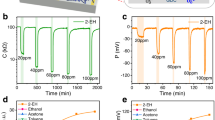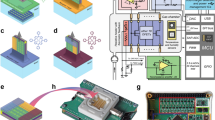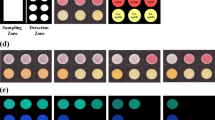Abstract
We have developed a simple colorimetric sensor array that detects a wide range of volatile analytes and then applied it to the detection of toxic gases. The sensor consists of a disposable array of cross-responsive nanoporous pigments with colours that are changed by diverse chemical interactions with analytes. Although no single chemically responsive pigment is specific for any one analyte, the pattern of colour change for the array is a unique molecular fingerprint. Clear differentiation among 19 different toxic industrial chemicals (TICs) within two minutes of exposure at concentrations immediately dangerous to life or health were demonstrated. Based on the colour change of the array, quantification of each analyte was accomplished easily, and excellent detection limits were achieved, generally below the permissible exposure limits. Different TICs were identified readily using a standard chemometric approach (hierarchical clustering analysis), with no misclassifications over 140 trials.
This is a preview of subscription content, access via your institution
Access options
Subscribe to this journal
Receive 12 print issues and online access
$259.00 per year
only $21.58 per issue
Buy this article
- Purchase on Springer Link
- Instant access to full article PDF
Prices may be subject to local taxes which are calculated during checkout






Similar content being viewed by others
References
Byrnes, M. E., King, D. A. & Tierno, P. M. Jr Nuclear, Chemical, and Biological Terrorism – Emergency Response and Public Protection (CRC Press, 2003).
Suslick, K. S. et al. Seeing smells: development of an optoelectronic nose. Quimica Nova 30, 677–681 (2007).
Suslick, K. S. An optoelectronic nose: seeing smells by means of colorimetric sensor arrays. MRS Bull. 29, 720–725 (2004).
Suslick, K. S., Rakow, N. A. & Sen, A. Colorimetric sensor arrays for molecular recognition. Tetrahedron 60, 11133–11138 (2004).
Rakow, N. A. & Suslick, K. S. A colorimetric sensor array for odour visualization. Nature 406, 710–713 (2000).
Hawkes, C. H. & Doty, R. L. The Neurology of Olfaction (Cambridge Univ. Press, 2009).
Zarzo, M. The sense of smell: molecular basis of odorant recognition. Biol. Rev. 82, 455–479 (2007).
Wang, J., Luthey-Schulten, Z. A. & Suslick, K. S. Is the olfactory receptor a metalloprotein? Proc. Natl Acad. Sci. USA 100, 3035–3039 (2003).
Gardner, J. W. & Bartlett, P. N. Electronic Noses: Principles and Applications (Oxford Univ. Press, 1999).
Lewis, N. S. Comparisons between mammalian and artificial olfaction based on arrays of carbon black–polymer composite vapor detectors. Acc. Chem. Res. 37, 663–672 (2004).
Röck, F., Barsan, N. & Weimar, U. Electronic nose: current status and future trends. Chem. Rev. 108, 705–725 (2008).
Hierlemann, A. & Gutierrez-Osuna, R. Higher-order chemical sensing. Chem. Rev. 108, 563–613 (2008).
Anslyn, E. V. Supramolecular analytical chemistry. J. Org. Chem. 72, 687–699 (2007).
Walt, D. R. Electronic noses: wake up and smell the coffee. Anal. Chem. 77, 45A (2005).
Wolfbeis, O. S. Materials for fluorescence-based optical chemical sensors. J. Mater. Chem. 15, 2657–2669 (2005).
Hsieh, M.-D. & Zellers, E. T. Limits of recognition for simple vapor mixtures determined with a microsensor array. Anal. Chem. 76, 1885–1895 (2004).
Janata, J. & Josowicz, M. Conducting polymers in electronic chemical sensors. Nature Mater. 2, 19–24 (2003).
Grate, J. W. Acoustic wave microsensor arrays for vapor sensing. Chem. Rev. 100, 2627–2647 (2000).
Rakow, N. A., Sen, A., Janzen, M. C., Ponder, J. B. & Suslick, K. S. Molecular recognition and discrimination of amines with a colorimetric array. Angew. Chem. Int. Ed. 44, 4528–4532 (2005).
Janzen, M. C., Ponder, J. B., Bailey, D. P., Ingison, C. K. & Suslick, K. S. Colorimetric sensor arrays for volatile organic compounds. Anal. Chem. 78, 3591–3600 (2006).
Zhang, C. & Suslick, K. S. A colorimetric sensor array for organics in water. J. Am. Chem. Soc. 127, 11548–11549 (2005).
Zhang, C., Bailey, D. P. & Suslick, K. S. Colorimetric sensor arrays for the analysis of beers: a feasibility study. J. Agric. Food Chem. 54, 4925–4931 (2006).
Zhang, C. & Suslick, K. S. Colorimetric sensor array for soft drink analysis. J. Agric. Food Chem. 55, 237–242 (2007).
Lim, S. H., Musto, C. J., Park, E., Zhong, W. & Suslick, K. S. A colorimetric sensor array for detection and identification of sugars. Org. Lett. 10, 4405–4408 (2008).
Bang, J. H., Lim, S. H., Park, E. & Suslick, K. S. Chemically responsive nanoporous pigments: colorimetric sensor arrays and the identification of alipathic amines. Langmuir 24, 13168–13172 (2008).
Musto, C. J., Lim, S. H. & Suslick, K. S. Colorimetric detection and identification of natural and artificial sweeteners. Anal. Chem. 81, 6526–6533 (2009).
Podbielsk, H., Ulatowska-Jarza, A., Muller, G. & Eichler, H. J. Optical Chemical Sensors (Springer, 2006).
Dunbar, R. A., Jordan, J. D. & Bright, F. V. Development of chemical sensing platforms based on sol–gel-derived thin films: origin of film age vs. performance trade-offs. Anal. Chem. 68, 604–610 (1996).
Jeronimo, P. C. A., Araujo, A. N. & Montenegro, M. Optical sensors and biosensors based on sol–gel films. Talanta 72, 13–27 (2007).
Rottman, C., Grader, G., De Hazan, Y., Melchior, S. & Avnir, D. Surfactant-induced modification of dopants reactivity in sol–gel matrixes. J. Am. Chem. Soc. 121, 8533–8543 (1999).
Steumpfle, A. K., Howells, D. J., Armour, S. J. & Boulet, C. A. Final Report of International Task Force 25: Hazard From Toxic Industrial Chemicals (US GPO, Washington, DC) http://file.sunshinepress.org:54445/us-uk-ca-mou-itf25-1996.pdf (1996).
Armour, S. J. et al. International Task Force 40: Toxic Industrial Chemicals (TICs)—Operational and Medical Concerns (US GPO, Washington, DC) <http://chppm-www.apgea.army.mil/desp/pages/jeswg/4QFY01/itf-40-2US.ppt> (2001).
Hill, H. H. & Martin, S. J. Conventional analytical methods for chemical warfare agents. Pure Appl. Chem. 74, 2281–2291 (2002).
Hammond, M. H. et al. A novel chemical detector using cermet sensors and pattern recognition methods for toxic industrial chemicals. Sens. Actuat. B 116, 135–144 (2006).
Meier, D. C. et al. The potential for and challenges of detecting chemical hazards with temperature-programmed microsensors. Sens. Actuat. B 121, 282–294 (2007).
Hasswell, S. Practical Guide To Chemometrics (Dekker, 1992).
Scott, S. M., James, D. & Ali, Z. Data analysis for electronic nose systems. Microchim. Acta 156, 183–207 (2007).
Johnson, R. A. & Wichern, D. W. Applied Multivariate Statistical Analysis 6th edn (Prentice Hall, 2007).
Hair, J. F., Black, B., Babin, B., Anderson, R. E. & Tatham, R. L. Multivariate Data Analysis 6th edn (Prentice Hall, 2005).
Acknowledgements
This work was supported through the National Institutes of Health Genes, Environment and Health Initiative through award U01ES016011.
Author information
Authors and Affiliations
Contributions
S.H.L. and L.F. contributed equally to the design of experiments, collection and analysis of data, and drafting of the manuscript, with assistance from J.W.K. and C.J.M. K.S.S. originated the central idea, oversaw the design of experiments and data analysis and contributed to the writing of the manuscript.
Corresponding author
Supplementary information
Supplementary information
Supplementary information (PDF 853 kb)
Rights and permissions
About this article
Cite this article
Lim, S., Feng, L., Kemling, J. et al. An optoelectronic nose for the detection of toxic gases. Nature Chem 1, 562–567 (2009). https://doi.org/10.1038/nchem.360
Received:
Accepted:
Published:
Issue Date:
DOI: https://doi.org/10.1038/nchem.360
This article is cited by
-
The development progress of multi-array colourimetric sensors based on the M13 bacteriophage
Nano Convergence (2023)
-
Artificial olfactory sensor technology that mimics the olfactory mechanism: a comprehensive review
Biomaterials Research (2022)
-
A facile way to construct sensor array library via supramolecular chemistry for discriminating complex systems
Nature Communications (2022)
-
Determination of quasi-primary odors by endpoint detection
Scientific Reports (2021)
-
Fully integrated ultra-sensitive electronic nose based on organic field-effect transistors
Scientific Reports (2021)



